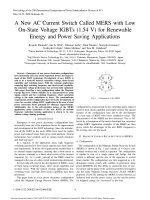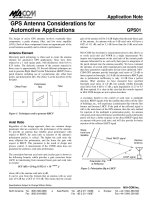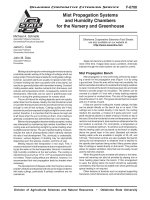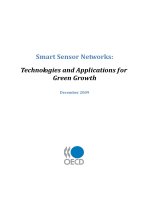Advanced microsystems for automotive applications 2010 smart systems for green cars and safe mobility ( TQL )
Bạn đang xem bản rút gọn của tài liệu. Xem và tải ngay bản đầy đủ của tài liệu tại đây (27.35 MB, 453 trang )
Advanced Microsystems
for Automotive Applications 2010
Gereon Meyer · Jürgen Valldorf
Advanced Microsystems
for Automotive
Applications 2010
Smart Systems for Green Cars
and Safe Mobility
123
Dr. Gereon Meyer
VDI/VDE Innovation + Technik GmbH
Steinplatz 1
10623 Berlin
Germany
Dr. Jürgen Valldorf
VDI/VDE Innovation + Technik GmbH
Steinplatz 1
10623 Berlin
Germany
ISBN 978-3-642-12647-5
e-ISBN 978-3-642-16362-3
DOI 10.1007/978-3-642-16362-3
Springer Heidelberg Dordrecht London New York
c 2010 Springer-Verlag Berlin Heidelberg
This work is subject to copyright. All rights are reserved, whether the whole or part of the material is
concerned, specifically the rights of translation, reprinting, reuse of illustrations, recitation, broadcasting,
reproduction on microfilm or in any other way, and storage in data banks. Duplication of this publication
or parts thereof is permitted only under the provisions of the German Copyright Law of September 9,
1965, in its current version, and permission for use must always be obtained from Springer. Violations
are liable to prosecution under the German Copyright Law.
The use of general descriptive names, registered names, trademarks, etc. in this publication does not
imply, even in the absence of a specific statement, that such names are exempt from the relevant protective
laws and regulations and therefore free for general use.
Coverdesign: deblik, Berlin
Printed on acid-free paper
Springer is part of Springer Science+Business Media (www.springer.com)
Preface
The automobile of the future has to meet two primary requirements: the
super-efficient use of energy and power and the ultra-safe transportation of
people and goods. Both features are increasingly enabled by smart, adaptive
and context aware information and communication technologies (ICT), electrical or electronic components and systems rather than solely by the mechanical means of classic automotive engineering. The most advanced example of
this trend is the electrified vehicle combining a full electric powertrain with
completely electronic controls like smart power and energy managers, steerby-wire technologies and intelligent networking capabilities allowing all providers and consumers of energy to work in efficient synergy.
In the course of this year the first series production electric vehicles will finally
come into the market. Automakers – unsure if electric vehicles would really
sell – have long time been hesitant to make the necessary changes of their
product portfolios. In the coincidence of economic crisis and growing concerns
about global warming and energy security companies and public authorities
jointly succeeded to overcome many obstacles on the path towards electrification.
It has been the mission of the International Forum on Advanced Microsystems
for Automotive Applications (AMAA) for more than twelve years now to detect
paradigm shifts and to discuss their technological implications at an early
stage. Previous examples from the fields of active safety, driver assistance, and
power train control can be found in many passenger cars today. The enabling
technologies of the electrified vehicle thus nicely fit into the scope of the conference. The heading of the 14th AMAA held in Berlin on 10-11 May 2010 is
“Smart Systems for Green Cars and Safe Mobility”. Among the co-organizers
is the European Technology Platform of Smart Systems Integration (EPoSS),
which in cooperation with the European Road Transport Research Advisory
Council (ERTRAC) and the SmartGrids platform is now playing a major role in
the Public Private Partnership European Green Cars Initiative.
The book at hand is a collection of papers presented by engineers from leading companies and world-class academic institutions at the AMAA 2010 conference. They address ICT, components and systems for electrified vehicles,
power train efficiency, road and passenger safety, driver assistance and traffic
management. Highlights of the contributions include energy management and
power train architectures of electrified and optimized conventional vehicles,
autonomous collision avoidance, safety at intersections, as well as a number
of features of car-to-car and car-to-infrastructure communication applications
including the use of Galileo navigation data for traffic management. Being
typical for the AMAA the presented applications are complimented by recent
sensor and actuator developments, e.g. active engine management sensors,
advanced camera systems, and active vehicle suspensions.
We would like to thank all authors for making this book an outstanding source
of reference for contemporary research and development in the field of ICT,
components, and systems for the automobile of the future. The time and
effort that the members of the AMAA Steering Committee spent on making
their assessments are particularly acknowledged. We like to thank also the
European Commission, EPoSS, and all industrial sponsors for their continuous
support of the AMAA.
In our role as the editors and conference chairs we would like to point out that
preparing a book like this is a serious piece of hard work built upon the endurance and enthusiasm of a multitude of great people. Our particular thanks
goes to Laure Quintin for running the AMAA office as well as to Anita Theel,
Michael Strietzel, and David Müssig for technical preparations of the book,
and to all other involved colleagues at VDI|VDE-IT. We also want to express
our deep gratitude to Wolfgang Gessner for his leadership and for continuous
support of the AMAA project.
Berlin, May 2010
Dr. Gereon Meyer
Dr. Jürgen Valldorf
Funding Authority
European Commission
Supporting Organisations
European Council for Automotive R&D (EUCAR)
European Association of Automotive Suppliers (CLEPA)
Advanced Driver Assistance Systems in Europe (ADASE)
Zentralverband Elektrotechnik- und Elektronikindustrie e.V. (ZVEI)
Mikrosystemtechnik Baden-Württemberg e.V.
Hanser Automotive
mst/news
enabling MNT
Organisers
European Technology Platform on Smart Systems Integration (EPoSS)
VDI|VDE Innovation + Technik GmbH
Honorary Committee
Eugenio Razelli
President and CEO,
Magneti Marelli S.P.A., Italy
Rémi Kaiser
Director Technology and Quality
Delphi Automotive Systems Europe, France
Nevio di Giusto
President and CEO
Fiat Research Center, Italy
Karl-Thomas Neumann
Executive Vice President E-Traction
Volkswagen Group, Germany
Steering Committee
Mike Babala
Serge Boverie
Geoff Callow
TRW Automotive, Livonia MI, USA
Continental AG, Toulouse, France
Technical & Engineering Consulting,
London, UK
Bernhard Fuchsbauer
Audi AG, Ingolstadt, Germany
Kay Fürstenberg
Sick AG, Hamburg, Germany
Wolfgang Gessner
VDI|VDE-IT, Berlin, Germany
Roger Grace
Roger Grace Associates, Naples FL, USA
Klaus Gresser
BMW Forschung und Technik GmbH,
Munich, Germany
Horst Kornemann
Continental AG, Frankfurt am Main,
Germany
Hannu Laatikainen
VTI Technologies Oy, Vantaa, Finland
Günter Lugert
Siemens AG, Munich, Germany
Roland Müller-Fiedler
Robert Bosch GmbH, Stuttgart, Germany
Paul Mulvanny
QinetiQ Ltd., Farnborough, UK
Andy Noble
Ricardo Consulting Engineers Ltd.,
Shoreham-by-Sea, UK
Pietro Perlo
Fiat Research Center, Orbassano, Italy
Detlef E. Ricken
Delphi Delco Electronics Europe GmbH,
Rüsselsheim, Germany
Christian Rousseau
Renault SA, Guyancourt, France
Patric Salomon
4M2C, Berlin, Germany
Florian Solzbacher
University of Utah, Salt Lake City UT, USA
Egon Vetter
Ceramet Technologies Ltd., Melbourne,
Australia
David Ward
MIRA Ltd., Nuneaton, UK
Hans-Christian von der Wense Freescale GmbH, Munich, Germany
Conference Chairs:
Gereon Meyer
Jürgen Valldorf
VDI|VDE-IT, Berlin, Germany
VDI|VDE-IT, Berlin, Germany
Table of Contents
Electrified Vehicles
Embedded Systems: The Migration from ICE Vehicles to Electric
Vehicles
3
M. Ottella, P. Perlo, Centro Ricerce Fiat
O. Vermesan, SINTEF
R. John, Infineon Technologies
K. Gehrels, NXP Semiconductors
H. Gall, austriamicrosystems
J. Aubert, FICOSA International
Green Combustion Cars Drive on Electric (BLDC) Motors
13
D. Leman, Melexis
Achieving Efficient Designs for Energy and
Power Systems of Electric Vehicles
21
E. Larrodé, J. Gallego, S. Sánchez, Universidad of Zaragoza
Inverter Losses Reduction Control Techniques
for Plug-In HEV and FEV Traction Drive
29
F. Cheli, D. Tarsitano, F. Mapelli, Politecnico di Milano
Start&Stop Energy Management Strategy for a Plug-In HEV:
Numerical Analysis and Experimental Test
39
F. Cheli, F. Mapelli, R. Viganò, D. Tarsitano, Politecnico di Milano
Smart Power Control and Architecture
for an Efficient Vehicle Alternator - Capacitor - Load System
51
L. Brabetz, M. Ayeb, D. Tellmann, J. Wang, Universität of Kassel
Advanced Mobile Information and Planning Support for EVs (MIPEV) 61
P. Bouteiller, Finfortec GmbH
P. Conradi, Steinbeis GmbH
TU VeLog: A Small Competitive Autarkic GPS Data Logging System
F. Schüppel, S. Marker, P. Waldowski, V. Schindler
Technische Universität Berlin
69
Monitoring of Batteries and
Variable Dynamic Behaviour of an Electric Vehicle
79
E. Cañibano, J. Romo, M.-I. González, L. De Prada, S. Benito, A. Pisonero,
CIDAUT Foundation
Power Train Efficiency
Vehicle Energy Management – Energy Related Optimal
Operating Strategies for CO2 Reduction
89
Th. Eymann, Bosch Engineering GmbH
A. Vikas, Robert Bosch GmbH
Active Engine Management Sensors for Power Train Efficiency
101
P. Slama, Infineon Technologies Austria AG
Thermal Systems Integration for Fuel Economy - TIFFE
109
C. Malvicino, R. Seccardini, Centro Ricerche Fiat
Estimation of the Driver-Style Economy
and Safety Via Inertial Measurements
121
S. M. Savaresi, V. Manzoni, A. Corti, Politecnico di Milano
P. De Luca, Teleparking Srl
Safety & Driver Assistance
Stable Road Lane Model Based on Clothoids
133
C. Gackstatter, P. Heinemann, S. Thomas, Audi Electronics Venture GmbH
G. Klinker, Technische Universität München
Utilizing Near-Infrared and Colour Information in an Automotive
Wide-Dynamic-Range Night Vision System for Driver Assistance
145
D. Hertel, C. De Locht, Melexis
ADOSE – Bio-Inspired In-Vehicle Sensor Technology
for Active Safety
J. Kogler, Ch. Sulzbachner, E. Schoitsch, W. Kubinger, M. Litzenberger,
AIT Austrian Institute of Technology GmbH
155
Improving Pedestrian Safety in Urban Scenarios
Through Autonomous Collision Avoidance
165
M. Roehder, S. Humphrey, B. Giesler, Audi Electronics Venture GmbH
K. Berns, Universität Kaiserslautern
Saferider On Bike Information System
177
R. Montanari, A. Spadoni, University of Modena and Reggio Emilia
M. Pieve, Piaggio s.p.a.
M. Terenziani, MetaSystem s.p.a
S. Granelli, AvMap s.r.l.
The Multi-Functional Front Camera Challenge and Opportunity
189
A. Tewes, M. Nerling, H. Henckel, Hella Aglaia Mobile Vision GmbH
An Occupancy Grid Based Architecture for ADAS
199
O. Aycard, T. D. Vu, Q. Baig, Université Grenoble 1
A Concept Vehicle for Rapid Prototyping of
Advanced Driver Assistance Systems
211
R. Schubert, E. Richter, N. Mattern, P. Lindner, G. Wanielik,
Technische Universität Chemnitz
Intersection Safety
INTERSAFE-2: Progress on Cooperative Intersection Safety
223
B. Roessler, D. Westhoff, Sick AG
Intersection Safety for Heavy Goods Vehicles
Safety Application Development
233
M. Ahrholdt, G. Grubb, E. Agardt, Volvo Technology Corporation
Progress of Intersection Safety System Development:
Volkswagen Within the INTERSAFE-2 Project
241
J. Knaup, S. Herrmann, M.-M. Meinecke, M. A. Obojski, Volkswagen AG
On-Board 6D Visual Sensor for Intersection Driving Assistance
S. Nedevschi, T. Marita, R. Danescu, F. Oniga, S. Bota, I. Haller, C. Pantilie,
M. Drulea, C. Golban, Universitatea Tehnica din Cluj-Napoca
253
Cooperative Intersection Infrastructure Monitoring System
265
M. Kutila, P. Pyykönen, J. Yliaho, VTT Technical Research Centre of Finland
B. Rössler, Sick AG
Components & Systems
From Sensors to Sensor Systems
279
S. Günthner, B. Schmid, A. Kolbe, Continental
Solutions for Safety Critical Automotive Applications
289
M. Osajda, Freescale Semiconductor
Secure Wireless Control Area Network
297
D. T. Nguyen, J. Singh, H. P. Le, B. Soh, LaTrobe University
Design and Control of a Linear Electromagnetic Actuator
for Active Vehicle Suspension
311
J. Wang, W. Wang, University of Sheffield
S. Tuplin, M. C. Best, Loughborough University
Optimising Efficiency using Hardware Co-Processing
for the CORDIC Algorithm
325
A. Glascott-Jones, P. Kuntz, T. Masson, P.A. Pinconcely, B. Diasparra,
A. Tatat, F. Berny, F. Salvi, M. Fadlallah, e2v
D. Kerr-Munslow, Cortus
Microsensor Based 3D Inertial Measurement System
for Motion Tracking in Crash Tests
337
F. Niestroj, J. Melbert, Ruhr-Universität Bochum
Virtual Reality and Hardware In-the-Loop Testing Methods
in the eCall In-Vehicle Module Research and Verification
347
J. Merkisz, Poznan University of Technology
R. Grzeszczyk, Automex sp. z.o.o.
2020 Auto Sensor Vision
R. Dixon, J. Bouchaud, iSuppli Corporation
357
Traffic Management
Towards an Active Approach to Guaranteed Arrival Times
Based on Traffic Shaping
367
D. Marinescu, M. Bouroche, V. Cahill, Trinity College Dublin
Simulation Process for Vehicle Applications Depending on
Alternative Driving Routes Between Real-World Locations
377
A. Lamprecht, Technische Universität München
T. Ganslmeier, Audi Electronics Venture GmbH
Priority System and Information Workflow for BHLS Services:
An Interregional Project Between Italy and Germany
387
S. Gini, G. Ambrosino, MemEx srl
P. Frosini, Resolvo srl
F. Schoen, Università di Firenze
H. Kirschfink, Momatec GmbH
iTETRIS - A System for the Evaluation
of Cooperative Traffic Management Solutions
399
D. Krajzewicz, German Aerospace Center
R. Blokpoel, Peek Traffic bv
F. Cartolano, Comune di Bologna
P. Cataldi, EURECOM
A. Gonzalez, O. Lazaro, Innovalia Association
J. Leguay, Thales Communication France
L. Lin, Hitachi Europe Ltd.
J. Maneros, CBT Comunicación & Multimedia
M. Rondinone, Universidad Miguel Hernández de Elche
A Comprehensive Simulation Tool Set for Cooperative Systems
411
T. Benz, PTV AG
R. Kernchen, University Surrey
M. Killat, KIT
A. Richter, DLR
B. Schünemann, FOKUS
GuideWeb: A New Paradigm for Navigation Support
based on V2V Communication
B. X. Weis, A. Sandweg, BlackForestLightning
423
Road Course Estimation Using Local Maps and Digital Maps
433
M. Konrad, K. Dietmayer, Universität Ulm
M. Szczot, Daimler AG
Galileo GNSS Based Mobility Services
443
R. Uhle, SAP AG
Appendices
Appendix A: List of Contributors
453
Appendix B: List of Keywords
459
Embedded Systems: The Migration from ICE Vehicles to Electric Vehicles
Embedded Systems: The Migration from ICE Vehicles to
Electric Vehicles
M. Ottella, P. Perlo, Centro Ricerce Fiat
O. Vermesan, SINTEF
R. John, Infineon Technologies
K. Gehrels, NXP Semiconductors
H. Gall, austriamicrosystems
J. Aubert, FICOSA International
Abstract
Future generations of electric vehicles (EVs) will require a new level
of convergence between computer and automotive architectures,
with the electric power train being a mechatronic system that
includes a multitude of plug and play devices, embedded power and
signal processing hardware, software and high level algorithms. This
paper discusses the current advances in the computing devices, communication systems and management algorithms embedded in the
EV building blocks used for implementing the distributed energy
and propulsion architectures required for high efficiency, reduced
complexity and safe redundancy.
1
Vehicle Architecture and Systems
The aim of the new electric vehicle architectures which are based on distributed embedded computing and power electronic systems, is to achieve significant energy saving capabilities, an enhanced fun-to-drive experience, increasing safety and comfort while decreasing the overall complexity of the vehicle.
Further objective includes reducing the overall system design cost.
At present the electronic devices in conventional ICE-propelled vehicles [1] can
be divided into four domains: Power train, Chassis, Body and Infotainment,
each offering different functional and computational characteristics:
Power train controllers require high computational power and stringent time constraints to run complex control algorithms in short sampling periods (ranging from 100 µs to 1 ms).
Chassis controllers still require high computational power, but also
multi-task operation capabilities within strict trigger timing constraints,
3
4
Electrified Vehicles
i.e. running safety critical tasks (steering, braking). Sampling periods
are usually in the order of some milliseconds.
Body controllers run fewer critical tasks with less stringent time constraints and sampling periods (in the order of some seconds). They also
run some safety-critical applications, e.g. airbag ignition.
Infotainment controllers perform no critical functions but require
operational features such as upgradeability, plug-and-play capabilities,
high and fluid bandwidth and security.
a)
b)
Fig. 1. Complexity in the vehicle - (a) the vehicle today (b) the vehicle tomorrow.
Embedded Systems: The Migration from ICE Vehicles to Electric Vehicles
In addition, the overall signal distribution system serves each domain by performing the necessary communication services, inside and outside the vehicle
(Vehicle-to-Vehicle – “V2V” and Vehicle to Infrastructure – “V2I”).
Fig. 2.
ICE vehicle architecture, building blocks and domain partition.
In EVs the overall architecture can be thought of as a multi-layered hierarchical structure with similar domains having different boundaries (Fig. 2):
Energy sources: Power electronic modules, control hardware and
firmware, and high level algorithms performing the functions of energy/
power storage (battery/super capacitors) overall management (cell
charge/discharge/equalisation functions, failure management functions,
etc) and recharging (grid connection, range-extension, photovoltaic)
Propulsion: Control modules and control algorithms, power modules
and electrical motors performing core power functions (traction torque
distribution, energy recuperation and conversion).
Chassis: Power modules and electric actuators performing steering,
braking and active suspension. Control algorithms performing stability
control, ABS, ESP, etc.
Vehicle body and on-board control: Performing master supervision,
human machine interface (HMI), comfort, infotainment and driver
assistance functions.
5
6
Electrified Vehicles
Fig. 3.
EV architecture, building blocks and domain partition hierarchy.
The interconnection among the various domains of the vehicle is demanded to
the Power and Signal Distribution system also featuring V2V, V2I, Vehicle to
Grid and Internet Connection (V2G+I).
2
Embedded Systems Computing Platforms
Embedded systems are penetrating the automotive industry very rapidly
with software and electronics currently accounting for some 35% of the cost
of premium vehicles [2]. A significant growth is expected for full EVs because
of distributed energy sources, storage units, power converters, motors, electromechanical chassis devices and novel high-speed power and signal distribution
systems.
ICE vehicles are characterised by a low number of concentrated high-power
computing units, whereas new generations of EVs are characterised by a high
number of low computational power units.
For instance, modern Engine Control Units (ECUs) require up to 500 Mega
instructions per second necessary to handle complex critical fail-safe tasks.
Incremental evolutions of ICEs, including combustion chamber pressure control,
Embedded Systems: The Migration from ICE Vehicles to Electric Vehicles
Fig. 4.
Trends in computational power in conventional (ICE) powertrains.
valve position control, oil condition control and exhaust gas composition sensors and control, are expected to require even greater computational power.
It is expected that the EV architecture will be more computational intensive
than the ICE one, in that most functions will be performed through electrical
and electronic devices. However, in the newer generations of EVs, in analogy
with biological systems, the complexity will be minimised by evolving into an
optimal trade-off between local and central computing/sensing while preserving safety and reliability. This will require significant improvements in the
standardisation and implementation of fail safe computing platforms demanding for high speed time triggered communication and computation tasks.
Fig. 5.
The four-leg principle for sprinter and runner: distributed
propulsion, distributed power.
7
8
Electrified Vehicles
3
AUTOSAR Reference Platform for Smart, Swift and Safe System
Integration
The design of embedded systems starts with an efficient development process in which dedicated and heterogeneous hardware (HW) and software (SW)
modules are integrated into subsystems and systems. The process must follow
guidelines that enable simultaneous reusability of components and algorithms
by standardisation and traceability of functions (and eventually faults) through
consistent multi-layered abstractions.
Specifically for automotive embedded systems the AUTOSAR1 concepts and
methodologies [3] paves the way for managing the electronic system complexity, improving the cost-efficiency, safety, reliability and upgradeability throughout the service life of the vehicle, which is a major issue for both manufacturers
and consumers of future electric vehicles.
The implementation of the layered architecture presented in figure 6 ensures
that the applications and the high level functions are decoupled from the
underlying hardware and software services. This enables the design of highly
distributed systems: the runtime environment (RTE) ensures communication
between hardware and software components regardless of the topology.
Fig. 6.
AUTOSAR layered reference platform.
Embedded Systems: The Migration from ICE Vehicles to Electric Vehicles
In addition the future evolution of AUTOSAR is the key for high level of safetyintegrity levels (ASIL2 D: Failure rate < 10-8 / h) [4], as it enables the development of a methodology that can easily be mapped on those defined by the ISO
262623 standard.
4
Power Distribution and Communication Systems: Smart Power
Cables, Wireless.
EVs architectures are demanding a new level of safety and reliability to be
deployed for in- and off-vehicle communication where mechanical systems will
be substituted 100% by electrical systems. As a consequence the in-vehicle
networks are becoming the backbone of EVs. In addition the evolution towards
a distributed embedded system platform is closely related with the development of high speed automotive communication systems: the characteristics
of high bandwidth (>10 Mbps) time triggering and fault-tolerance make
FlexRay the preferred candidate protocol for the distributed electric propulsion. Moreover the interaction of the vehicle with the forthcoming infrastructures will also require new fast and secure wireless implementations (WAVE,
IEEE 802.11p, LTE, etc.).
The presence of high electrical and magnetic fields, with the related electromagnetic compatibility and interference (EMC-EMI) issues, pose a new level
of design complexity because of the tight interaction between high power
distribution lines and high speed wired and wireless communications media.
The major issue is then to address networking architectures and dedicated
components to achieve high radiation immunity.
Moreover to perform in-vehicle networking immune from interferences, a viable option is foreseen in the implementation of smart shielded power cabling
which will also reduce the potentially harmful magnetic field emissions.
5
Conclusions
In summary the migration from ICE based vehicles to the full electric ones,
will change the overall domain partitioning and their boundary conditions
together with the distribution of the core system functions. With respect to
the conventional vehicle, more functions will be performed by distributed
embedded systems. Communication protocols will play a crucial role in that
high speed protocols (i.e. FlexRay) will be required for a safe and reliable
management of the architecture.
9
10
Electrified Vehicles
1 AUTOSAR (Automotive Open System Architecture) is an open and standardized automotive software architecture, jointly developed by automobile manufacturers, suppliers and tool developers.
It is a partnership of automotive OEMs, suppliers and tool vendors whose objective is to create and
establish open standards for automotive E/E (Electrics/Electronics) architectures that will provide a
basic infrastructure to assist with developing vehicular software, user interfaces and management
for all application domains. This includes the standardization of basic systems functions, scalability to different vehicle and platform variants, transferability throughout the network, integration
from multiple suppliers, maintainability throughout the entire product lifecycle and software updates and upgrades over the vehicle's lifetime as some of the key goals.
2 Automotive Safety Integrity Level (ASIL) is defined in ISO 26262 as a relative level of risk-reduction provided by a safety function, or to specify a target level of risk reduction. In simple terms,
ASIL is a measurement of performance required for a Safety Instrumented Function (SIF).
3 International standard IEC 61511 was published in 2003 to provide guidance to end-users on the
application of Safety Instrumented Systems in the process industries. This standard is based on IEC
61508, a generic standard for design, construction, and operation of electrical/electronic/programmable electronic systems. Automotive sector has its own standard based on IEC 61508: ISO 26262
(for road vehicles, currently a draft international standard).
Embedded Systems: The Migration from ICE Vehicles to Electric Vehicles
References
[1]
[2]
[3]
[4]
Simonot-Lion, F., The design of safe automotive electronic systems: Some
problems, solution and open issues, Keynote speech, IES - IEEE Symposium on
Industrial Embedded Systems, Antibes, France, Oct 18-20, 2006.
Charlette, R. N., This car runs on code, IEEE Spectrum online edition Feb 2009.
Furst, S., AUTOSAR – An Open Standardized software architecture for the automotive industry, 1st AUTOSAR Open Conference & 8th AUTOSAR Premium
Member Conference, October 23rd, Detroit, MI, USA, 2008.
Lafouasse, B., AUTOSAR for Electric Vehicles at SVE – Dassault Group, Vector
Congress, Oct 2008.
Marco Ottella, Pietro Perlo
Centro Ricerche Fiat
Strada Torino, 50
10043 Orbassano
Italy
Ovidiu Vermesan
SINTEF
Forskningsvn. 1
0314 Oslo
Norway
Reiner John
Infineon AG
81726 Munich
Germany
Kees Gehrels
NXP Semiconductors
Building FT3.135
Jonkerbosplein 52
6534AB Nijmegen
The Netherlands
11









